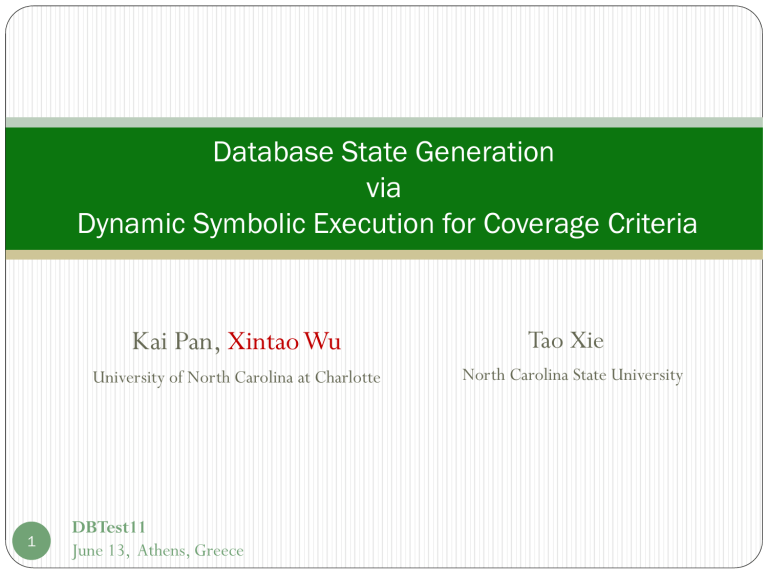PPTX

Database State Generation via
Dynamic Symbolic Execution for Coverage Criteria
Kai Pan, XintaoWu
University of North Carolina at Charlotte
Tao Xie
North Carolina State University
1
DBTest11
June 13, Athens, Greece
2
We leverage DSE as a supporting technique to generate database states to achieve high code coverage
(BVC and CACC in addition to branch coverage).
3
Outline
Introduction:
-- Dynamic Symbolic Execution(DSE)
-- Advanced structural coverage criteria(BVC and LC)
Approach
Evaluation
Related work
Conclusion and future work
4
Dynamic Symbolic Execution(DSE) -- Revisited
DSE: An effective automatic test-input generation approach that combines concrete execution with symbolic execution
Details:
-- Starts with default or arbitrary inputs and executes the program concretely
-- Performs symbolic execution to collect symbolic constraints on the inputs simultaneously
-- Flips a branch condition and conjuncts it with constraints from the prefix of the executed path
-- Sends the conjuncted conditions to a constraint solver to generate new inputs for the uncovered paths
5
DSE in Testing Database Applications -- Revisited
When DSE is applied on database applications, the symbolic execution collects constraints over both the program inputs and the symbolic database, by symbolically tracking the concrete SQL queries executed along the execution path
Generates both program input values and corresponding database records via a constraint solver
Related work:
M.Emmi, R.Majumdar, and K.Sen. Dynamic test input generation for database applications. In ISSTA, 2007.
K. Taneja, Y. Zhang, and T. Xie. MODA: Automated Test Generation for Database
Applications via Mock Objects. In ASE 2010
6
Boundary Value Coverage
Boundary Value Coverage(BVC): requires to execute programs using values from both the input range and boundary conditions. This is because program errors tend to occur at extreme or boundary points.
Example: for integers A and B in one expression, we have:
7
Logical Coverage
Logical Coverage (LC): involves instantiating clauses in a logical expression (predicate) with concrete truth values.
Predicate/Clause/Combinatorial/Active Clause coverage
Correlated Active Clause Coverage (CACC), value of a logical expression is directly dependent on the value of the clause that we want to test
Formally, for each predicate p and each major clause c i
p, choose minor clauses c j
p.(required that p(c i
, j≠ i so that c
= true) ≠ p(c i i determines
= false).)
∈
8
Enforcing CACC and BVC
Example: in the example code (Line 20), for the predicate pc4 = (bal>=250000||employed && married) with the target evaluation result as true
We choose rows 1 and 4 from the table to enforce CACC
9
Enforcing CACC and BVC(cont’d)
To enforce BVC on the clause “(bal>=250000)”, we get
{bal=250000, bal>250000, bal=maximum}
For the entire predicate, we get the following six instantiations:
{bal=250000, employed=true, married=false},
{bal>250000, employed=true, married=false},
{bal=maximum, employed=true, married=false},
{bal=250000-1, employed=true, married=true},
{bal<250000-1, employed=true, married=true},
{bal=minimum, employed=true, married=true}.
10
Enforcing CACC and BVC(cont’d)
In general, given a predicate and a boolean evaluation as input, we generate instantiations using:
CACC
BVC
11
Our work
Our approach leverages DSE to track how the inputs to the program under test are transformed before appearing in the executed queries and how the constraints on query results affect the later program execution.
We use Pex, a state-of-the-art DSE engine for .NET to illustrate our idea
The approach can be extended to other DSE engines for other programming languages
12
Pex APIs
APIs provided by Pex help users fetch symbolic expressions:
--
PexSymbolicValue.ToString() to get the target query string at each query execution point
--
PexSymbolicValue.GetRelevantInputNames<Type>() to detect the data dependency between the execution point and program input parameters.
--
PexSymbolicValue.GetPathConditionString() to retrieve the path condition at the execution point
Illustrative example
Our focus: how to generate sufficient database states to satisfy BVC and CACC .
Challenges:
1. Input parameters involved in both embedded queries and branch conditions(e.g. int
inputAge)
2. Branch conditions involve variables that are related with returned database attribute
13 values(e.g. Line 20)
14
Illustrative example(cont’d)
We use path P (where branch conditions in Lines 03, 08, 16, and
20 are true) and program inputs
(type = 0, inputAge = 30) as an example
We get path condition PC = pc1 ∧ pc2 ∧ pc3 ∧ pc4, where pc1 = (type
== 0), pc2 = (inputAge > 25), pc3
= (results.Read() == true), and pc4
= ((bal >= 250000 || employed && married) == true).
type=0,inputAge=30
Illustrative example(cont’d)
We get the concrete executed query string
Q :
SELECT C.SSN, C.jobStatus, C.marriage, M.balance
FROM customer C, mortgage M
WHERE M.year=15 AND C.SSN=M.SSN
And C.age=40 and the symbolic query string Qsym:
SELECT C.SSN, C.jobStatus, C.marriage, M.balance
FROM customer C, mortgage M
WHERE M.year
=:years AND C.SSN=M.SSN
AND C.age
=:fAge
15
16
Illustrative example(cont’d)
For Q and Qsym, the WHERE clause contains host variables that appear directly in branch conditions or are dependent on host variables in branch conditions (Line 08)
Hence, enforcing BVC on this branch condition (Line 08) incurs constraints on the generated data.
17
Illustrative example(cont’d)
Branch condition (Line 20) contains three host variables (bal,
employed, and married) that retrieve values from three database attributes (M.balance,
C.jobStatus, C.marriage) in the returned result set
Enforcing CACC and BVC on the branch condition(Line 20) incurs new constraints on the generated data
18
Embedded query(in a DPNF form):
Part1: Deriving constraints by examining the WHERE clause and the branch conditions before the query’s execution.
Part2:Deriving constraints by examining the SELECT clause and the branch conditions after the query’s execution.
19
Deriving Constraints from Embedded Query
Constraints from executed queries:
20
Deriving Constraints from Embedded Query(cont’d)
Set C
Q
= (A
11
AND …AND A
1n
) OR … OR (A m1
AND
…AND A mn
) --- the WHERE clause of Q sym
For each A ij
, we check whether it contains host variables.
For each contained host variable,
if it is related with any branch condition, we add it to V
Q and replace it with symbolic string expressed by variables in the related branch conditions.
Otherwise, we replace the variable with its concrete value contained in the concrete query.
21
Deriving Constraints from Embedded Query(cont’d)
Using our example code:
-- C
Q
= {M.year= :years AND C.SSN= M.SSN AND C.age=: fAge }.
-For M.year=:years , we replace “ years” with the value “ 15” .
-- For C.age=:fAge , we replace “ fAge” with “ inputAge + 10” .
-- For C.SSN= M.SSN, we leave it unchanged.
-- C
Q
= {M.year= 15 AND C.SSN= M.SSN AND C.age=: inputAge + 10 }.
22
Deriving Constraints from Embedded Query(cont’d)
Next, we check whether the branch condition pc along the execution path contains host variables related with the WHERE clause.
If yes, we enforce it with both CACC and BVC and get instantiations I pc
We refine C
Q as C
Q
= C
Q
× I pc
.
23
Deriving Constraints from Embedded Query(cont’d)
Using our example code:
-- Enforcing BVC on inputAge> 25, we have instantiations
{inputAge=25+1, inputAge>25+1, inputAge=maximum}.
-C
Q is then updated as
{M.year=15 AND C.SSN= M.SSN AND C.age=:inputAge+10 AND inputAge=25+1},
{M.year=15 AND C.SSN= M.SSN AND C.age=:inputAge+10 AND inputAge>25+1},
{M.year=15 AND C.SSN= M.SSN AND C.age=:inputAge+10 AND
inputAge=maximum}.
24
Deriving Constraints related with Query Result Set
For branch conditions after the SQL’s execution point, we check whether they contain host variables that are dependent on database attributes in the SELECT clause, and then enforce CACC and BVC.
25
Deriving Constraints related with Query Result Set(cont’d)
Using our example code: pc4 = ((bal >= 250000 || employed && married) == true) , we have C
R
{bal=250000, employed=true, married=false},
{bal>250000, employed=true, married=false},
{bal=maximum, employed=true, married=false},
{bal=250000-1, employed=true, married=true},
{bal<250000-1, employed=true, married=true},
{bal=minimum, employed=true, married=true}.
We then replace host variables (e.g., bal) with database attributes (e.g., M.balance).
26
Combining Constraints
Finally, the set C = C
Q
×C
R contains constraints on the generated database state to enforce CACC and BVC on the source code under test.
We send C together with the schema level constraints C
S to a constraint solver (Z3) to conduct the data instantiation
27
Evaluation
We conduct evaluations on two open source database applications.
RiskIt: 4.3K non-commented lines of code, a database containing13 tables, 57 attributes, and more than 1.2 million records
UnixUsage: 2.8K non-commented lines of code, a database containing 8 tables, 31 attributes, and more than 0.25 million records
We choose methods that have boundary values and/or logical expressions in branch conditions from the applications.
28
Evaluation(cont’d)
To measure CACC and BVC, we apply a tool [Pandita et
al. ICSM10] that transforms the problem of achieving
CACC and BVC to the problem of achieving block coverage by introducing new blocks through code instrumentation.
We use PexGoal.Reached() to identify whether each introduced block is covered. For example, the statement if (inputAge > 25) {...} in Line 08 becomes
29
Evaluation(cont’d)
We use the value of (n2 - n1)/n to capture the increase gained by
Pex assisted by our approach in achieving CACC and BVC.
n denotes the total number of PexGoal.Reached() statements introduced in each method.
n
1 denotes the number of covered PexGoal.Reached() statements when running Pex (in addition to our program input generation tool) without applying our algorithm to generate new records. n
2 denotes the number of covered PexGoal.Reached() statements when running Pex with the assistance of our algorithm.
30
Evaluation(cont’d)
Evaluation results: our approach assists Pex to reach the full CACC and BVC coverage (a 21.21% increase on average for RiskIt and a 46.43% increase for UnixUsage ).
31
Related work
Coverage criteria:
-- BVC and LC [ Ammann et al. ISSRE 2003, Kosmatov et al. ISSRE
2004 ]
-- test generation to reach high BVC and LC [ Pandita et al.
ICSM 2010 ]
DB application testing:
-- generating database states from scratch[ Chays and Shahid
DBTest 2008, Emmi et al. ISSTA 2007, Taneja et al. ASE 2010 ]
-- using existing database state[ Li and Csallner DBTest 2010,
Pan et al. UNC-Chalotte TR-2011 ]
32
Related work (cont’d)
SQLFpc (short for SQL Full Predicate Coverage)
A coverage criterion focusing on an isolated SQL statement, based on the Modified Condition/Decision
Coverage(MC/DC).
Mutates a given SQL query statement into a set of queries that satisfy MC/DC with the aim of detecting faults in the
SQL statement .
[Tuya et al. 2010, Riva et al. AST 2010].
Our work leaves the embedded SQL statement unchanged. Instead, we generate database states with the aim of detecting faults in source code .
33
Conclusion
We developed a general approach to generating test database states that can achieve BVC and CACC in database application testing.
We expect that testers can detect more faults that occur in boundaries or involve complex logical expressions.
We implemented our approach in Pex, a DSE tool for
.NET. Our evaluation demonstrated the feasibility of our approach.
34
Future work
We plan to investigate how to optimize the constraint collection and data instantiation.
We plan to study complex SQL queries (e.g.,
GROUPBY queries with aggregations) and extend our technique to multiple queries.
35
Thank you! Questions?
Acknowledgment: This work was supported in part by U.S. National Science
Foundation under CCF-0915059 for Kai Pan and XintaoWu, and under CCF-
0915400 for Tao Xie.





